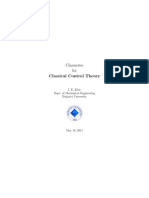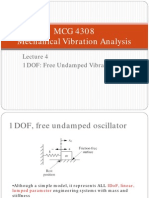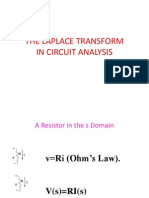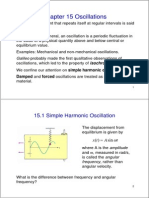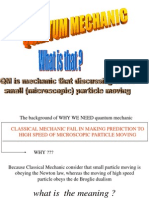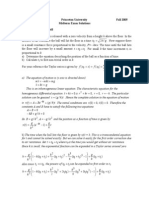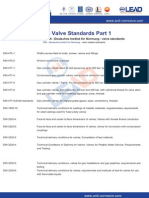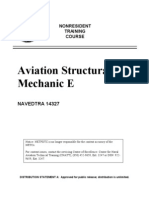Applications Hamilton Principle
Uploaded by
Geof180Applications Hamilton Principle
Uploaded by
Geof180Applications of Hamiltons Principle and Euler-Lagranges Equations
A continuum bar with one end xed and the other atttached to spring/mass is shown below.
Fixed support K Continuum bar (EA, L) M
f(t) us(t)
1. Theoretical Basis: Kinetic energy of the contimuun bar: Tbar =
1 2 L 0
m(x) u t (x, t) d x,
2
u(x, t) u t (x, t) = t
(1)
Potential energy of the continuum bar: Vbar =
1 2 L 0
{ E A(x) u x (x, t) } d x,
2
u(x, t) u x (x, t) = x
(2)
External energy due to applied force f(t): Ws = f(t) u s (t) d x (3)
Kinetic energy of the discrete mass: Ts = 1 M u s (t)2 (t) 2 Potential energy of springs: Vs = 1 K [u s (t) u(L , t)]2 2 (5) (4)
Hamiltons principle for the bar and discrete mass-spring system:
t2 t1
[Ttotal Vbar Vs +Wbar ] dt = 0,
Ttotal = Tbar + Ts (6)
Variation of the foregoing Hamiltons principle
t2 t1 0 L
{[(x)u(x, t) + E A(x) u x x (x, t)] u(x, t)}d x (7)
{M u s (t) + K [u s (t) u(L , t)] f (t)} u s (t) {[(E A(x) u x (x, t) + K [u(L , t) u s (t)] u(x, t)}x=L {E A(x) u x (x, t)u(x, t)}x=0 dt = 0
The governing equations of motion: (x)u(x, t) E A u x x (x, t) = 0 M u s (t) + K (u s (t) u(L , t)) = f (t) The boundary conditions: u(0, t) = 0 (10) (8) (9)
E A(x) u x (L , t) + K [u(L , t) u s (t)] = 0
(11)
Example Problem: Application of Hamiltons Principle
O k a y O k a +x A a: original spring length x: extension C L y
C m, L F
mg X
F X
mg
Step 1 (same as in HW1): Obtain the position vectors. r A = (a + x)i L rC = (a + x)i + (cos i + sin j) 2 r B = (a + x)i + L(cos i + sin j) r A = ai L rC = ai + i 2 r B = ai + Li
(12)
The virtual displacement needed for computing the generalized forces: (13) r B = x i + L( sin i + cos j)
Step 2: Obtain the kinetic energy of the system. rC L = xi + ( sin i + cos j) 2 (14)
T = 1 m rC rC + 1 IC 2 2 2
L 2 2 m L2 2 = 1 m[x 2 L x sin + ]+ 1 2 2 12 4
(15)
Step 3: Compute the potential energy due to gravity and spring, and the nonconservative virtual work. Potential energy due to spring: FA
spring
= k r A = kxi,
0 x
dr A = d xi (16)
V spring =
FA
spring
dr A = 1 kx 2 2
Potential energy due to gravity:
gravit y FC
= mgi, rr e f rC
0 x
drC
L = d xi + ( sin i + cos j)d 2 drC
0
V gravit y = =
FC
spring
mgL mgd x 2
mgL (1 cos ) sin d = mgx + 2 (17)
Total potential energy: V =V
spring
+V
gravit y
1 2 2 kx
mgL mgx + (1 cos ) 2
(18)
Nonconservative generalized forces: Fnoncons = F( sin i + cos j), r B = xi + L( sin i + cos j) B Wnoncons = Fnoncons r B B = F sin x + F L = Q x x + Q Q = F L Q x = F sin , (19)
Step 4: Obtain the equations of motion via Hamilton-Euler-Lagranges formalism. The generalized coordinates: (q1 = x, q2 = ). The Lagrangian: L 2 2 mgL 2 1 1 2 sin + ][ 2 kx mgx+ (1cos )] L = T V = 2 m[x L x 3 2 (20) The generalized forces: Q x = F sin , Q = F L .
Substituting the preceding expressions into d L L ( ) = Qk , dt qk qk we nally obtain m L2 m L sin cos + kx = mg F sin mx 2 2 m L 2 m L x mgL sin = sin + F L 3 2 2 q1 = x, q2 = (21)
(22)
You might also like
- Continuous Azimuth Measurement Fluctuation When Drilling North-South - 5675177 - 01No ratings yetContinuous Azimuth Measurement Fluctuation When Drilling North-South - 5675177 - 0111 pages
- CS 410/510 - Software Engineering System Modeling: The Big PictureNo ratings yetCS 410/510 - Software Engineering System Modeling: The Big Picture6 pages
- SCI 121 - Introduction To Physics & Chemistry Formula Sheet 1 KinematicsNo ratings yetSCI 121 - Introduction To Physics & Chemistry Formula Sheet 1 Kinematics10 pages
- Microsoft Powerpoint - 3-Introduction To Dynamic AnalysisNo ratings yetMicrosoft Powerpoint - 3-Introduction To Dynamic Analysis37 pages
- Files-3-Handouts Solved Problems Chapter 3 Mechanical Systems PDFNo ratings yetFiles-3-Handouts Solved Problems Chapter 3 Mechanical Systems PDF7 pages
- 08 Differential Equations - Second Order LDE ApplicationsNo ratings yet08 Differential Equations - Second Order LDE Applications25 pages
- FALLSEM2013-14 CP1806 30-Oct-2013 RM01 II OptimalControl UploadedNo ratings yetFALLSEM2013-14 CP1806 30-Oct-2013 RM01 II OptimalControl Uploaded10 pages
- Mechanical Vibration of Continuous MediaNo ratings yetMechanical Vibration of Continuous Media47 pages
- Given A Potential Energy Graph, Oscillations Will Occur Between Turning Points Determined byNo ratings yetGiven A Potential Energy Graph, Oscillations Will Occur Between Turning Points Determined by9 pages
- MAPS Equation Sheet For 8.011: Model: Dynamics and Net ForceNo ratings yetMAPS Equation Sheet For 8.011: Model: Dynamics and Net Force4 pages
- Introduction To Simulation - Lecture 16: Methods For Computing Periodic Steady-State - Part IINo ratings yetIntroduction To Simulation - Lecture 16: Methods For Computing Periodic Steady-State - Part II32 pages
- Classnotes For Classical Control Theory: I. E. K Ose Dept. of Mechanical Engineering Bo Gazici UniversityNo ratings yetClassnotes For Classical Control Theory: I. E. K Ose Dept. of Mechanical Engineering Bo Gazici University51 pages
- Classical Mechanics Notes Variational Principles and Lagrange EquationsNo ratings yetClassical Mechanics Notes Variational Principles and Lagrange Equations11 pages
- Conservation of Mechanical Energy, Linear MomentumNo ratings yetConservation of Mechanical Energy, Linear Momentum6 pages
- L7 - Engineering Method For Dynamic Aeroelasticity100% (1)L7 - Engineering Method For Dynamic Aeroelasticity19 pages
- CH 15 Kinetics of Particles Impulse and MomentumNo ratings yetCH 15 Kinetics of Particles Impulse and Momentum24 pages
- Module I: Electromagnetic Waves: Lecture 9: EM RadiationNo ratings yetModule I: Electromagnetic Waves: Lecture 9: EM Radiation26 pages
- 18 Exercise Solutions: Exercise 2-1. Addition of Two Complex-Valued Signals Is Illustrated BelowNo ratings yet18 Exercise Solutions: Exercise 2-1. Addition of Two Complex-Valued Signals Is Illustrated Below3 pages
- Chapter 15 Oscillations: 15.1 Simple Harmonic OscillationNo ratings yetChapter 15 Oscillations: 15.1 Simple Harmonic Oscillation8 pages
- One Dimension Free Fermions Green's Function: Ext ExtNo ratings yetOne Dimension Free Fermions Green's Function: Ext Ext6 pages
- Ecuaciones Diferenciales Parciales de Logan - Chapter 2 SolutionsNo ratings yetEcuaciones Diferenciales Parciales de Logan - Chapter 2 Solutions14 pages
- ES2A7 - Fluid Mechanics Example Classes Example Questions (Set IV)No ratings yetES2A7 - Fluid Mechanics Example Classes Example Questions (Set IV)8 pages
- Assignment - 2 - Updated Solution - ME354ANo ratings yetAssignment - 2 - Updated Solution - ME354A13 pages
- Present. Chapter 1 Schrodinger EquationNo ratings yetPresent. Chapter 1 Schrodinger Equation20 pages
- Time-Continous Stochastic Processes 0. Time Continous Stochastic ProcessesNo ratings yetTime-Continous Stochastic Processes 0. Time Continous Stochastic Processes10 pages
- Lecture 3: State-Feedback, Observers, Reference Values, and Integrators Problem FormulationNo ratings yetLecture 3: State-Feedback, Observers, Reference Values, and Integrators Problem Formulation8 pages
- Fluctuation-Dissipation Theorem (FDT) : 1 Classical MechanicsNo ratings yetFluctuation-Dissipation Theorem (FDT) : 1 Classical Mechanics6 pages
- 1 General Solution To Wave Equation: One Dimensional WavesNo ratings yet1 General Solution To Wave Equation: One Dimensional Waves35 pages
- Student Solutions Manual to Accompany Economic Dynamics in Discrete Time, secondeditionFrom EverandStudent Solutions Manual to Accompany Economic Dynamics in Discrete Time, secondedition4.5/5 (2)
- Mathematical Formulas for Economics and Business: A Simple IntroductionFrom EverandMathematical Formulas for Economics and Business: A Simple Introduction4/5 (4)
- Computer Programs SP2: A Computer Program For Plotting Stereographic Projection and Exploring Crystallographic Orientation RelationshipsNo ratings yetComputer Programs SP2: A Computer Program For Plotting Stereographic Projection and Exploring Crystallographic Orientation Relationships5 pages
- Calculation of Cogging Force in Permanent Magnet Linear Motor Using Analytical and Finite Element MethodsNo ratings yetCalculation of Cogging Force in Permanent Magnet Linear Motor Using Analytical and Finite Element Methods6 pages
- CD40160BMS, CD40161BMS, CD40162BMS, CD40163BMS: CMOS Synchronous Programmable 4-Bit Counters FeaturesNo ratings yetCD40160BMS, CD40161BMS, CD40162BMS, CD40163BMS: CMOS Synchronous Programmable 4-Bit Counters Features13 pages
- WEEK 8: Lecture 8: ROR Multiple Alternatives: October 26-30, 2020No ratings yetWEEK 8: Lecture 8: ROR Multiple Alternatives: October 26-30, 202029 pages
- 1MRB520050-Uen Operating Instructions REL316-4No ratings yet1MRB520050-Uen Operating Instructions REL316-4986 pages
- Toad For Oracle Editions 2017 Functional MatrixNo ratings yetToad For Oracle Editions 2017 Functional Matrix9 pages
- Polymer Testing: Frédéric Achereiner, Kurt Engelsing, Martin Bastian, Peter HeidemeyerNo ratings yetPolymer Testing: Frédéric Achereiner, Kurt Engelsing, Martin Bastian, Peter Heidemeyer8 pages
- Physics Chapterwise Objective QuestionsNo ratings yetPhysics Chapterwise Objective Questions24 pages
- CoolFlex Application Report - KW Per RackNo ratings yetCoolFlex Application Report - KW Per Rack6 pages
- SOT SOAP Assignment Report: I. One SOAP Service Which With Four MethodsNo ratings yetSOT SOAP Assignment Report: I. One SOAP Service Which With Four Methods4 pages
- Cambridge International General Certificate of Secondary EducationNo ratings yetCambridge International General Certificate of Secondary Education12 pages
- Continuous Azimuth Measurement Fluctuation When Drilling North-South - 5675177 - 01Continuous Azimuth Measurement Fluctuation When Drilling North-South - 5675177 - 01
- CS 410/510 - Software Engineering System Modeling: The Big PictureCS 410/510 - Software Engineering System Modeling: The Big Picture
- SCI 121 - Introduction To Physics & Chemistry Formula Sheet 1 KinematicsSCI 121 - Introduction To Physics & Chemistry Formula Sheet 1 Kinematics
- Microsoft Powerpoint - 3-Introduction To Dynamic AnalysisMicrosoft Powerpoint - 3-Introduction To Dynamic Analysis
- Files-3-Handouts Solved Problems Chapter 3 Mechanical Systems PDFFiles-3-Handouts Solved Problems Chapter 3 Mechanical Systems PDF
- 08 Differential Equations - Second Order LDE Applications08 Differential Equations - Second Order LDE Applications
- FALLSEM2013-14 CP1806 30-Oct-2013 RM01 II OptimalControl UploadedFALLSEM2013-14 CP1806 30-Oct-2013 RM01 II OptimalControl Uploaded
- Given A Potential Energy Graph, Oscillations Will Occur Between Turning Points Determined byGiven A Potential Energy Graph, Oscillations Will Occur Between Turning Points Determined by
- MAPS Equation Sheet For 8.011: Model: Dynamics and Net ForceMAPS Equation Sheet For 8.011: Model: Dynamics and Net Force
- Introduction To Simulation - Lecture 16: Methods For Computing Periodic Steady-State - Part IIIntroduction To Simulation - Lecture 16: Methods For Computing Periodic Steady-State - Part II
- Classnotes For Classical Control Theory: I. E. K Ose Dept. of Mechanical Engineering Bo Gazici UniversityClassnotes For Classical Control Theory: I. E. K Ose Dept. of Mechanical Engineering Bo Gazici University
- Classical Mechanics Notes Variational Principles and Lagrange EquationsClassical Mechanics Notes Variational Principles and Lagrange Equations
- Conservation of Mechanical Energy, Linear MomentumConservation of Mechanical Energy, Linear Momentum
- L7 - Engineering Method For Dynamic AeroelasticityL7 - Engineering Method For Dynamic Aeroelasticity
- Module I: Electromagnetic Waves: Lecture 9: EM RadiationModule I: Electromagnetic Waves: Lecture 9: EM Radiation
- 18 Exercise Solutions: Exercise 2-1. Addition of Two Complex-Valued Signals Is Illustrated Below18 Exercise Solutions: Exercise 2-1. Addition of Two Complex-Valued Signals Is Illustrated Below
- Chapter 15 Oscillations: 15.1 Simple Harmonic OscillationChapter 15 Oscillations: 15.1 Simple Harmonic Oscillation
- One Dimension Free Fermions Green's Function: Ext ExtOne Dimension Free Fermions Green's Function: Ext Ext
- Ecuaciones Diferenciales Parciales de Logan - Chapter 2 SolutionsEcuaciones Diferenciales Parciales de Logan - Chapter 2 Solutions
- ES2A7 - Fluid Mechanics Example Classes Example Questions (Set IV)ES2A7 - Fluid Mechanics Example Classes Example Questions (Set IV)
- Time-Continous Stochastic Processes 0. Time Continous Stochastic ProcessesTime-Continous Stochastic Processes 0. Time Continous Stochastic Processes
- Lecture 3: State-Feedback, Observers, Reference Values, and Integrators Problem FormulationLecture 3: State-Feedback, Observers, Reference Values, and Integrators Problem Formulation
- Fluctuation-Dissipation Theorem (FDT) : 1 Classical MechanicsFluctuation-Dissipation Theorem (FDT) : 1 Classical Mechanics
- 1 General Solution To Wave Equation: One Dimensional Waves1 General Solution To Wave Equation: One Dimensional Waves
- Student Solutions Manual to Accompany Economic Dynamics in Discrete Time, secondeditionFrom EverandStudent Solutions Manual to Accompany Economic Dynamics in Discrete Time, secondedition
- Shortcuts to College Calculus Refreshment KitFrom EverandShortcuts to College Calculus Refreshment Kit
- Mathematical Formulas for Economics and Business: A Simple IntroductionFrom EverandMathematical Formulas for Economics and Business: A Simple Introduction
- Computer Solved: Nonlinear Differential EquationsFrom EverandComputer Solved: Nonlinear Differential Equations
- Computer Programs SP2: A Computer Program For Plotting Stereographic Projection and Exploring Crystallographic Orientation RelationshipsComputer Programs SP2: A Computer Program For Plotting Stereographic Projection and Exploring Crystallographic Orientation Relationships
- Calculation of Cogging Force in Permanent Magnet Linear Motor Using Analytical and Finite Element MethodsCalculation of Cogging Force in Permanent Magnet Linear Motor Using Analytical and Finite Element Methods
- CD40160BMS, CD40161BMS, CD40162BMS, CD40163BMS: CMOS Synchronous Programmable 4-Bit Counters FeaturesCD40160BMS, CD40161BMS, CD40162BMS, CD40163BMS: CMOS Synchronous Programmable 4-Bit Counters Features
- WEEK 8: Lecture 8: ROR Multiple Alternatives: October 26-30, 2020WEEK 8: Lecture 8: ROR Multiple Alternatives: October 26-30, 2020
- Polymer Testing: Frédéric Achereiner, Kurt Engelsing, Martin Bastian, Peter HeidemeyerPolymer Testing: Frédéric Achereiner, Kurt Engelsing, Martin Bastian, Peter Heidemeyer
- SOT SOAP Assignment Report: I. One SOAP Service Which With Four MethodsSOT SOAP Assignment Report: I. One SOAP Service Which With Four Methods
- Cambridge International General Certificate of Secondary EducationCambridge International General Certificate of Secondary Education
























